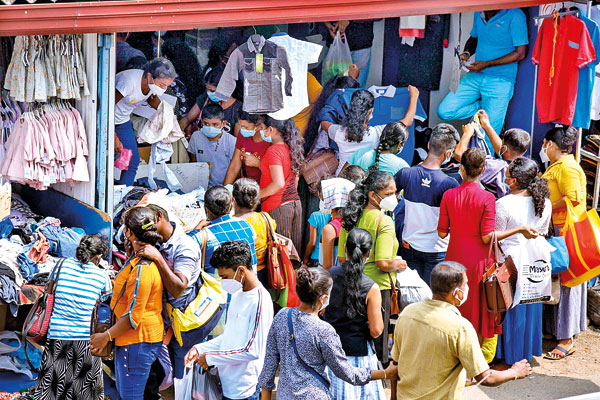News
‘Look to the past to prevent COVID-19 disaster in the future’

Avurudu shoppers in April this year : The Avurudu cluster spilled into the community and spread like wildfire. Pic by Akila Jayawardana
The way forward in living with the pandemic which has lasted nearly two years is to look back, learn from the past and move on, reiterates an expert who dabbles in microscopic life forms and also deals with patients.
“We need to address the core reasons which set off huge outbreaks in this COVID-19 pandemic,” points out Consultant Clinical Microbiologist, Dr. Mahen Kothalawala who has recently transferred to the National Hospital of Sri Lanka (NHSL) from the Kandy National Hospital.
He says that the pandemic spread is critically and closely linked to “human behaviour” and without changing human behaviour, “proper control” is an impossible task. It is also not just a “health problem” but a complicated issue with many contributory factors. Even if Sri Lanka achieves the desired level of vaccination, all preventive strategies should focus on changing human behaviour.
Referring to the Spanish flu pandemic which ravaged the world in 1918 for about one year, he says that it infected an estimated 500 million people, killing an estimated 20-50 million. However, it did not last as long as the current pandemic which has affected 219 million and killed 4.6 million, with no signs of abating.
The immediate past of the current pandemic throws up some interesting findings: super-spreader events set off huge waves of infections in different countries.
- United States of America (USA) – in early March 2020, the caseload was around 20 per day. Then came the Biogen super-spreading event in Boston, a conference at a hotel by this company, which studies have found led to around 30,000 cases per day, in a cascade effect, as the attendees went to their homes and communities.
- Sri Lanka– three such events were experienced in early and mid-2020. They were the navy cluster in April, the Kandakadu cluster in mid-May and the Mahara-Welikadaprison cluster in August. There were a large number of infections within small areas but they could be contained quickly, while Sri Lanka also had severe lockdowns.

Dr. Mahen Kothalawala
However, the same could not be said of the Minuwangoda (Brandix) cluster and the Peliyagoda fish market cluster in October-November-December 2020 and also the Avurudu cluster of April 2021 which spilled into the community and spread like wildfire, once again leading to lockdowns.
Explaining that all these super-spreading events lead to an exponential rise in infections in a short time, Dr. Kothalawala says that all the “waves” we have experienced in Sri Lanka have been preceded by one or more super-spreading event. The R0 value (in epidemiology, ‘R-nought’ represents the number of new infections estimated to stem from a single case) does not apply in the rapid spread of the disease in Sri Lanka.
The R0 value would apply, he argues, if a single contagious person comes into contact with a group of immunologically naïve individuals [having an immune system that has never been exposed to the new coronavirus (SARS-CoV-2)]. But in Sri Lanka, now about 10-15% of the population has been exposed to the virus.
Comparing and contrasting the R0 value and super-spreader events, he says:
- Under the R0 value modelling, if one infected person is among 1,000 of a naïve population, half of them would get infected within six cycles. There is geometrical progression of the infections.
- Super-spreader events, however, in contrast would set off a large number of infections in one single go and if there is a spill into the community, as usually there is, lead to massive outbreaks.
“Therefore, all preventive strategies should be to ‘contain’ an infection before it progresses to a super-spreader event,” says Dr. Kothalawala, pointing out that along with ‘pandemic fatigue’, they lead to waves of infections.
Turning the spotlight on pandemic fatigue, he says that it is an expected and natural response to a prolonged public health crisis intervention. It leads to boredom, depression, psychic numbing and other issues, making way for people to abandon preventive precautions and enhancing the risk of getting infected.
Next he looks at how Sri Lanka has controlled outbreaks.
Before vaccination it was lockdowns, but he cautions that people should not be overburdened by these restrictions. A lockdown will work only when the epidemiological curve of infections demonstrates geometrical progression, where every case will contribute to the transmission of the disease. COVID-19, however, behaves in a different manner. Around 80% of the infected people do not pass the infection to their contacts but 20% of the infected cause 80% of the cases.
“A multi-layered preventive strategy is the way ahead,” adds Dr. Kothalawala, taking into consideration all the possibilities –
- Variants continuing to fuel the pandemic.
- The virus suddenly disappearing from circulation.
- The virus getting attenuated (reduced in effect) and becoming like the ‘common cold coronaviruses’.
- The virus becoming seasonal, acquiring a transmission pattern like influenza (flu).
Dealing with these possibilities, he says that the likelihood of the sudden disappearance of the virus is low but he expects it to become attenuated and transform into the 5th circulating human coronavirus in time, like 229E (alpha coronavirus); NL63 (alpha coronavirus); OC43 (beta coronavirus); and HKU1 (beta coronavirus).
“The new coronavirus will be with us for a long time till it loses its virulence (severity and the ability to cause harm). Until such time, we have to change our lifestyle and live with it,” adds Dr. Kothalawala.
| Multi-layered preventive strategy essentialA multi-layered preventive strategy is the way forward, reiterates Dr. Mahen Kothalawala, pointing out that the more preventive layers there are, the more chances of success.“We should not put all the eggs in one basket. No single intervention can prevent the spread of disease. The main stakeholders should be the health sector with other groups such as the military being called in for vital support,” he says. Dr. Kothalawala points out that it is of paramount importance to identify the first “symptomatic case”. The people themselves should do it and strictly resort to isolation immediately to prevent a super-spreading event. “If you or a family member are feeling ill and have symptoms of COVID-19 (fever, sore throat, body aches and pains, etc.) don’t go to work or to the market. Don’t send your child to school. Isolate yourself immediately and seek medical help.” Referring to testing, he says that an RT-PCR positive sample does not necessarily mean that the person is contagious. Screening people who are asymptomatic (without symptoms), meanwhile, is a futile practice. While vaccination is considered the best option in the battle against COVID-19, it should be in tandem with other preventive measures, taking into consideration the key features of transmission. Some of these key features
| |

